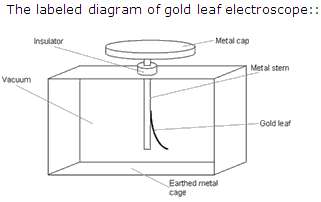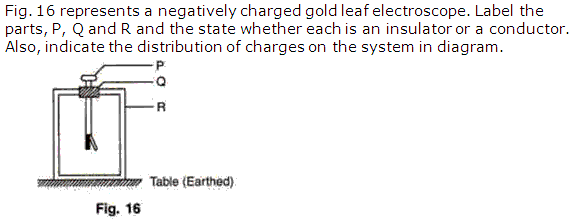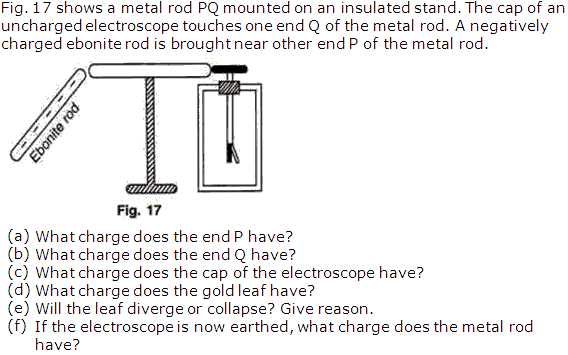FRANK Solutions for Class 9 Physics Chapter 8 - Electricity and Magnetism - Static Electricity
Chapter 8 - Electricity and Magnetism - Static Electricity Exercise 300
Question 1
What do you mean by electrostatics?
Solution 1
Electrostatics is defined as the study of charges at rest.
Question 2
What is quantization of charge?
Solution 2
The quantization of charge is the property by virtue of which every charge exists only in discrete lumps or packets of some minimum charge.
Question 3
Name a physical quantity, other than electric charge, which is quantized.
Solution 3
Energy other than electric charge is quantized.
Question 4
How many electrons are present in one coulomb?
Solution 4
Q = ne
N = Q/e = 1C / 1.6 x 10-19 = 6.25 x 1018
N = Q/e = 1C / 1.6 x 10-19 = 6.25 x 1018
Question 5
What is the other name of frictional electricity?
Solution 5
Frictional electricity is also known as static electricity.
Question 6
Name the scientist who first observed the electrical properties of amber.
Solution 6
Thales of Miletus was the scientist who observed the electric properties of amber.
Question 7
How many kinds of charges have you come across?
Solution 7
There are two kind of charges - positive and negative charge.
Question 8
What does a positively charged body signify?
Solution 8
A positively charged body signifies that its nucleus contains more number of protons than electrons.
Question 9
What does a negatively charged body signify?
Solution 9
A negatively charged body signifies that it contains number of electrons more than number of protons.
Question 10
Name the scientist who first assigned algebraic signs to charges.
Solution 10
Benjamin Franklin was the scientist who first assigned the algebraic signs to charges.
Question 11
What will happen when a glass rod is rubbed with some silk cloth?
Solution 11
When a glass rod is rubbed with silk,the glass rod acquires the positive charge.
Question 12
What type of charge is produced on an ebonite rod when it is rubbed with cat's fur?
Solution 12
When ebonite rod is rubbed with cat's fur, the ebonite rod acquires the negative charge.
Chapter 8 - Electricity and Magnetism - Static Electricity Exercise 301
Question 1
Which is bigger: 1 C or magnitude of charge on an electron?
Solution 1
1 C is bigger than charge on an electron.
Question 2
What is the value of charge on a body which carries 100 excess electrons?
Solution 2
Q = n e
The charge on an electron = -1.6 x 10-19
= 100 x 1.6 x 10-19 = 1.6 x 10-17
The charge on an electron = -1.6 x 10-19
= 100 x 1.6 x 10-19 = 1.6 x 10-17
Question 3
Is a charge of -3.6 X 10-18C possible?
Solution 3
Q = n e
N = Q/ e = -3.6 x 10-18 /1.6 x 10-19 = 22.5
Since, n is not an integral value so this value of charge is not possible because charge is quantized.
N = Q/ e = -3.6 x 10-18 /1.6 x 10-19 = 22.5
Since, n is not an integral value so this value of charge is not possible because charge is quantized.
Question 4
What is the origin of frictional forces?
Solution 4
The origin of frictional forces is electrical in nature.
Question 5
What is the cause of charging?
Solution 5
The cause of charging is the frictional forces between the two bodied when they are rubbed against each other.
Question 6
Who first showed two kinds of charges and who gave them algebraic signs?
Solution 6
The Sir Williams Gilbert was the scientist who showed two charges and Benjamin Franklin was the scientist who gave name to charges.
Question 7
State two differences between charge and mass.
Solution 7
Two differences between charge and mass are ::
(i) Electric charge can be positive , negative or zero while mass of the body is strictly positive.
(ii) Electric charge is quantized while the quantization of mass is not yet established.
(i) Electric charge can be positive , negative or zero while mass of the body is strictly positive.
(ii) Electric charge is quantized while the quantization of mass is not yet established.
Question 8
Is mass of the body affected on charging?
Solution 8
Yes, mass of the body get affected on charging.
Question 9
Consider three charged bodies A, B and C. If A and B repel each other and A attracts C, what is the nature of force between B and C?
Solution 9
There will be attractive force between the B and C because both carry opposite charges.
Question 10
How do the charges interact?
Solution 10
Unlike charges attract each other and like charges repel each other.
Question 11
Does motion of a body affect its charge?
Solution 11
No, the motion of the object does not affect the charge on the body.
Question 12
Name any two basic properties of electric charge.
Solution 12
The properties of an electric charge are - (1) Electric charges are quantized.
(2) Like charges repel each other while unlike charges attract each other.
(2) Like charges repel each other while unlike charges attract each other.
Question 13
Can ever photons have a charge? If not, why?
Solution 13
Photons can never have charge because charges never exist without rest mass.
Question 14
A glass rod rubber with silk cloth acquires a charge of +1.6 X 10-12C. What is the charge on the silk cloth?
Solution 14
The silk cloth will acquire the charge opposite to the charge of glass rod . So the charge acquired by silk cloth will be = -1.6 x 10 -19C.
Question 15
What is the SI unit of charge?
Solution 15
The S. I unit of charge is coulomb.
Question 16
What is the value of charge on an electron? Is a charge less than value possible?
Solution 16
The value of charge on an electron = -1.6 x 10-19C. No, the charge less than charge of an electron is not possible.
Question 17
What is the net charge on an atom?
Solution 17
The net charge on an atom is zero.
Question 18
What are free electrons?
Solution 18
The electrons of the outermost orbit of an atom are the free electrons and they easily leave their respective atoms and become free to move inside the solid.
Question 19
What is an ion? How are they formed?
Solution 19
An ion is an atom which has either gained one or more electrons or which has lost one or more electrons. When an atom's valence electrons leave their atom and become free to move inside the solid and move to another atom then positive ion is formed. And, the other atom which gain electrons become the negative ion.
Question 20
State the kind of charge on (i) a positive ion, (ii) a negative ion.
Solution 20
(i) On positive ion, there exist a positive charge.
(ii) On negative ion, there exists a negative charge.
(ii) On negative ion, there exists a negative charge.
Question 21
Describe an experiment to show that the like charges repel each other while the unlike charges attract.
Solution 21
If the electrified silk cloth or the ebonite rod are brought near to each other then they will repel each other but when electrified silk cloth and glass rod are brought together then they attract each other. The charges on the electrified silk cloth and ebonite rod is negatives while on glass rod , its positive so we can say that like charges repel each other while unlike charges attract each other.
Question 22
Sometimes when you take off your nylon clothes, your hair stand on their end. Explain the observation.
Solution 22
When the nylon cloth get rubbed with hairs then it acquires the negative charge because few free electrons get transferred from hairs to nylon and they get attracted towards nylon cloth so the hair stands on their end.
Question 23
The charge on a body is -1.8e. Is this statement true?
Solution 23
The charge is quantized and Q = ne where n should be only integer . Since Q = -1.8 e where n is not an integer. So, this charge is not possible.
Question 24
Draw a labeled diagram of a gold leaf electroscope.
Solution 24

Question 25
What is the purpose of an electroscope?
Solution 25
The purpose of an electroscope is to detect the presence of charge on the body and nature of charge (whether its positively charged or negatively charged) on the body.
Chapter 8 - Electricity and Magnetism - Static Electricity Exercise 302
Question 1

Solution 1
P is a Cap, Q is plug and R is the bottle in the negatively charged gold leaf electroscope. P is a conductor and Q, R is an insulator.
Question 2

Solution 2
(a) P will have the positive charge
(b) Q will have no charge.
(c) Cap of the electroscope will have no charge.
(d) The gold leaf will have negative charge.
(e) The leaf will diverse because like charges repel each other
(f) If electroscope is earthed then metal rod will have positive charge.
(b) Q will have no charge.
(c) Cap of the electroscope will have no charge.
(d) The gold leaf will have negative charge.
(e) The leaf will diverse because like charges repel each other
(f) If electroscope is earthed then metal rod will have positive charge.
Question 3
What is meant by the earthing of an electroscope?
Solution 3
Earthing of an electroscope is meant to take the thick copper strip inside the earth so that charges induced from thunderstorm on the metal spikes can move to earth to safeguard buildings from thunderstorm.

0 comments:
Post a Comment